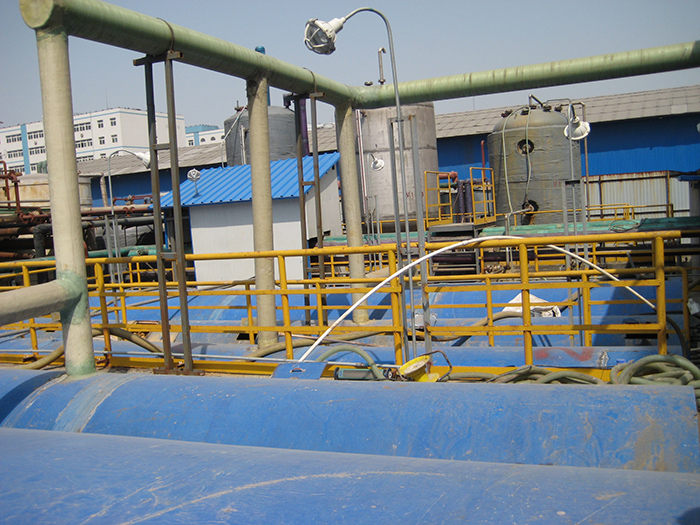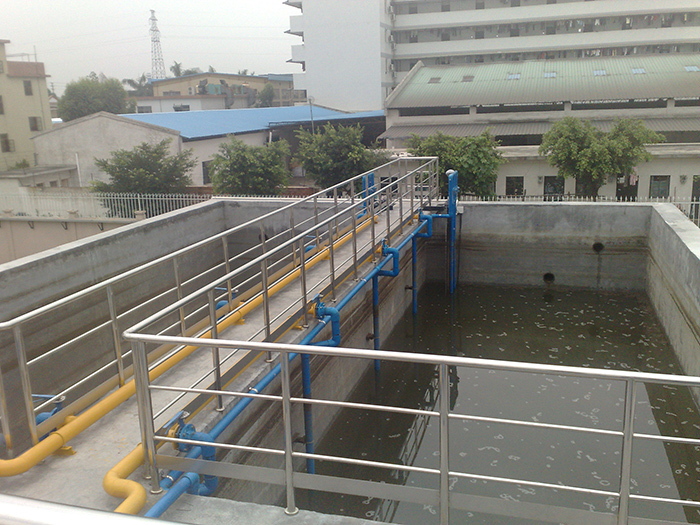HOME > Technical data > Nine technical treatment of industrial wastewater

Industrial wastewater treatment
Industrial waste water Refers to the industrial production process of wastewater, sewage and waste liquid, which contains with the water erosion is the industrial production of materials, intermediate products and product and manufacturing process of pollutants.With the rapid development of industry, increased rapidly in the amount and type of waste water, water pollution is widespread and serious, threatening human health and safety.Therefore, for protecting the environment, industrial wastewater treatment is more important than the urban sewage treatment.In many water treatment enterprises, henan zhonglan group in research and development production of sewage treatment equipment with advanced technical operation, using a first-class sewage wastewater treatment process, and solves the problem of a lot of industrial waste water treatment. The following brief introduction now new technologies of industrial waste water treatment.
Membrane technology
Membrane separation commonly used with micro filtration, nanofiltration, ultrafiltration and reverse osmosis technology, etc.Due to the membrane technology in the process without introducing other impurities, can realize the separation of large molecules and small molecules, so often used in all kinds of macromolecular materials recycling, such as using ultrafiltration technology recovery of polyvinyl alcohol paste printing and dyeing wastewater, etc.Current limiting membrane technology engineering application promotion is the main difficulty of the membrane of high cost, short service life, vulnerable to pollution and fouling congestion, etc.With the development of membrane production technology, membrane technology will get more and more application in the field of wastewater treatment.
Magnetic separation technology
Magnetic separation technology is in recent years the development of a new kind of impurity particles in waste water with water treatment technology of magnetic separation.For the non-magnetic or weak magnetic particles in water, using magnetic inoculation technology can make them with magnetic.There are three kinds of magnetic separation technology applied in wastewater treatment methods: direct magnetic separation, magnetic separation method and indirect microbial - magnetic separation.The current research of magnetic technology mainly include magnetic reunion, iron salts were heavy, iron powder, ferrite, etc., the typical magnetic separation equipment is disc magnetic separator and high gradient magnetic filter.Magnetic separation technology is still in the laboratory research stage at present, also cannot be applied to actual engineering practice.
Fenton and Fenton oxidation process
A typical Fenton reagent is produced by catalytic decomposition of H2O2 Fe2?OH, triggering the oxidation of organic matter degradation reaction.Since long time needed for processing wastewater Fenton method, using a test dose, and excessive Fe2 will increase after the wastewater treatment of COD and produce secondary pollution.In recent years, people to the introduction of the ultraviolet and visible light Fenton system, and adopt the other transition metal instead of Fe2, these methods can significantly enhance the capacity of Fenton reagent for the oxidation of organic matter degradation, reducing the amount of Fenton reagent, reduce processing costs, referred to as class Fenton reaction.Fenton method, mild reaction conditions, equipment is simple, applicable range is extensive;Applications can be used as a separate processing, can also be combined with other methods, such as coagulation and precipitation, activated carbon, biological treatment, such as combination, as the pretreatment of refractory organic wastewater or deep processing method.
Electrochemical catalytic oxidation
Electrochemical technology through the anodic reaction of (catalytic) degradation of organic matter directly, or through the anodic reaction to produce hydroxyl free radical (OH), ozone and other antioxidant degradation of organic matter.Electrochemical (catalytic oxidation including one-dimensional, two-dimensional and three-dimensional electrode system.Due to the effect of micro electrolysis electric field of the three-dimensional electrode system, is highly regarded.Three-dimensional electrode is in the traditional two-dimensional cell electrodes packing granular or other fragmental working electrode materials, and make the loading of the material surface charged, become the third pole, and electrochemical reactions can occur in working electrode material surface.Compared with two-dimensional plate electrode, the three-dimensional electrode has a large specific surface, can increase the surface of the cell than the body, can provide a larger current strength at lower current density, particle spacing small, material mass transfer rate is high, time and space conversion efficiency is high, so the current efficiency is high, the treatment effect is good.Three-dimensional electrode can be used for the treatment of sewage, pesticide, dye, pharmacy, and other refractory organic wastewater containing phenol wastewater, metal ions, garbage leachate, etc.
Iron carbon micro electrolysis treatment technology
Iron carbon galvanic cell micro electrolytic method is using Fe/C reaction principle to deal with waste water of good technology, also known as the electrolytic process, scrap iron filtering method, etc.Iron carbon micro electrolytic method is electrochemical oxidation reduction, electrochemical electricity the rightness of the flocs enrichment, and electrochemical reaction products of condensation, floc adsorption and new bed filtration effect such as comprehensive effect, mainly oxidation reduction and electric sets and cohesion function.Iron submerged in waste water containing a large amount of electrolyte, forming innumerable tiny galvanic cell, after adding coke in iron, iron and coke particle contact further big battery formation, make the iron on the basis of the micro by galvanic corrosion, and a large of galvanic corrosion, thus speeding up the electrochemical reaction.This method has a wide range of application, good treatment effect, long service life, low cost and convenient operation and maintenance, and many other advantages, and use scrap as raw material, also do not need to consume electricity, with the meaning of "using waste treat waste".The iron carbon micro electrolysis packing has been widely used in printing and dyeing, chemicals/pharmaceutical,, petrochemical and oil content of heavy metal wastewater and garbage leachate treatment, achieved good effect.TPFC iron carbon filler of the company research and development production of various kinds of wastewater treatment can view the effect of TPFC iron carbon micro electrolysis packing processing all kinds of waste water treatment effect.
Ozone oxidation
Ozone is a strong oxidant, and also the square one pollutant reaction speed, easy to use, does not produce secondary pollution, and can be used in the disinfection of wastewater, in addition to color, deodorant, removal of organic matter and reduce COD, etc.Separately using ozone oxidation process cost is high, the process is expensive, and with selective oxidation reaction, for some halogenated hydrocarbon oxidation effect such as pesticide and more bad.Therefore, in recent years the development of the relevant combination aims to improve the efficiency of ozone oxidation technology, including the UV/O3, H2O2 / O3, UV/H2O2 / O3 combination not only can improve the oxidation rate and efficiency, but also to ozone oxidation effect when alone is difficult to oxidation degradation of organic matter.Due to the low solubility of ozone in water, and ozone generation efficiency, low energy consumption, thus increasing the solubility of ozone in water, improve the utilization rate of ozone, the development of efficient and low energy consumption ozone generator become the main direction of research.
Wet catalytic oxidation
Wet catalytic oxidation method is in the high temperature (150 ~ 350 ℃) and high pressure (0.5 ~ 20 mpa), under the action of catalyst, the use of O2 or air as oxidant and catalyst (), () catalytic oxidation is dissolved or suspended photocatalyst in water of the organic matter or inorganic matter is square one, achieve the goal of removing pollutants.Wet air () oxidation process can be applied to urban sludge and acrylonitrile, coking, printing and dyeing and other industrial waste water and phenol, chlorine hydrocarbon, the processing of organic phosphorus pesticide wastewater, organic sulfur compounds.
Plasma water treatment technology
Low temperature plasma water treatment techniques, including water treatment technology and the high voltage pulse discharge plasma glow discharge plasma water treatment technology, is the use of discharge plasma in aqueous solution directly, or will the active gas discharge plasma particles is introduced into the water, can make the water pollutant thoroughly oxidation and decomposition.The direct pulse discharge in the aqueous solution can operate under atmospheric pressure, the whole discharge process without adding catalyst can be generated in the aqueous solution of in situ chemical oxidizing species oxidative degradation of organic matter, the technology for treatment of low concentration organic economic and effective.In addition, the application of water treatment technology of pulse discharge plasma reactor in the form of flexible adjustment, simple operation process, the corresponding maintenance cost is low.Restricted by discharge equipment, the process of the organic matter degradation energy utilization rate is low, the application of plasma technology in water treatment is still in development stage.
Ultrasonic oxidation
In 15 ~ 1000 KHZ frequency ultrasonic irradiation organic pollutants in water is caused by the physical and chemical process of cavitation effect.Ultrasound can not only improve the reaction conditions, to speed up the reaction rate and improve the reaction yield, still can make some chemical reactions to be realized.It combines the advanced oxidation, incineration, the characteristics of supercritical oxidation and so on the many kinds of water treatment technology, combined with simple operation, low to the requirement of equipment, in sewage treatment, especially in the degradation of waste water of high toxicity and refractory organic pollutants, to speed up the degradation of organic pollutants, realize the industrial waste water pollutant harmless, avoid the influence of the secondary pollution is of great significance.In recent years, the use of ultrasound to deal directly with or to strengthen the research on the treatment of organic wastewater is increasing, the content involves the degradation mechanism and kinetics, intermediate, influential factors, system optimization, etc.
Radiation technology
In the 1970 s, with the development of large cobalt and electron accelerator technology and the radiation source problems in application of radiation technology gradually improved.Of pollutants in wastewater treatment using radiation technology research attention and caught the attention of the countries.Compared with the traditional chemical oxidation, pollutants using radiation technology processing, do not need to join or just a small amount of adding chemical reagents, does not produce secondary pollution, degradation of high efficiency, fast response, and the advantages of pollutant degradation thoroughly.And, when the ionizing radiation and when used in combination with the catalytic oxidation methods such as oxygen, ozone, can produce "synergistic effect".Radiation technology processing, therefore, pollution is a kind of clean and sustainable utilization of technology, by the international atomic energy agency (iaea) as the main research direction of peaceful USES of atomic energy in 21st century.

Industrial wastewater treatment
[!--temp.fenxiang--]On one:Centrifugal pump the points for attention during the operation
The next:返回列表